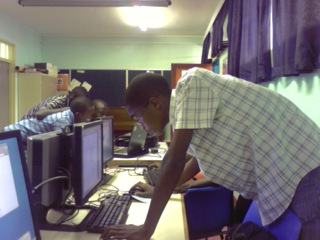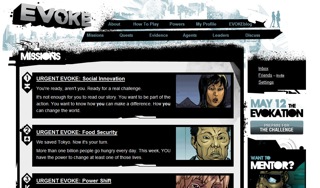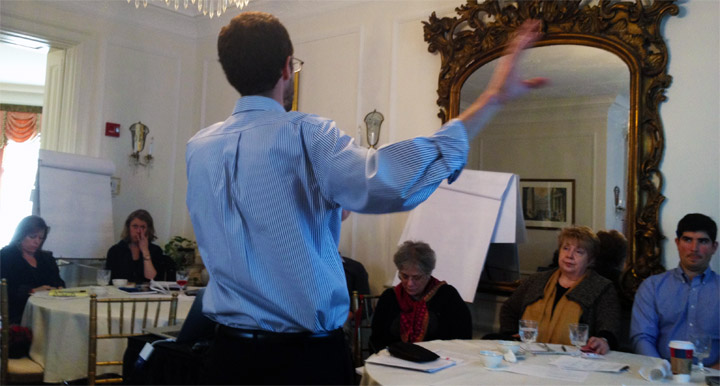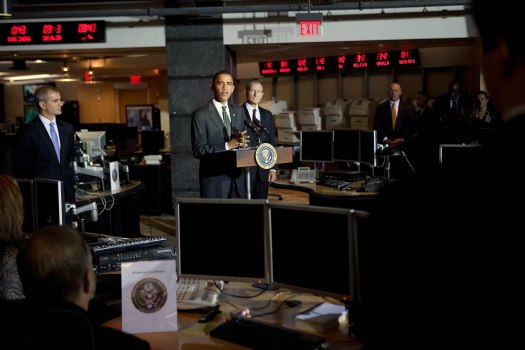 On March 3, 2010, the World Bank launched Urgent Evoke—an online video game designed to help individuals across the world develop innovative, creative solutions to the globe’s most pressing social problems while developing ten much-needed skills: collaboration, courage, creativity, entrepreneurship, local insight, knowledge sharing, resourcefulness, spark / example setting, sustainability, and vision.
On March 3, 2010, the World Bank launched Urgent Evoke—an online video game designed to help individuals across the world develop innovative, creative solutions to the globe’s most pressing social problems while developing ten much-needed skills: collaboration, courage, creativity, entrepreneurship, local insight, knowledge sharing, resourcefulness, spark / example setting, sustainability, and vision.
Over the course of the game’s ten-week inaugural round, participants from around the world logged onto the game’s site (via Internet, where available, but also over mobile telephones for those in developing countries lacking Internet access) every Wednesday at midnight to access a new “urgent evoke,” or a description of a problem that players would work to solve. The problems, presented in a comic book format to make the experience both fun and interactive, were real-life issues such as hunger, poverty, education, and human rights. With each new “urgent evoke,” players had the opportunity to research and learn about the issue, consider the challenge posed by the game’s designers that accompanied each “urgent evoke,” and accept the mission. Unlike most typical online video games, accepting the mission on Urgent Evoke did not bring players to a new, simulated world within which to complete that mission; rather, players were expected to act on the mission within their own communities and document their efforts with video, photos, or a blog post. In a third and final step, participants were asked to consider the issue of the week in the future, and to describe how the issue affected them then. Players earned points for completing each mission, and could be awarded more points by other players for such things as creativity and collaboration. At the end of the inaugural ten weeks, players were asked to submit their own “Evokation,” that is, a plan to tackle a problem. Players who completed all ten weeks of the game and submitted an “Evokation” received a certificate for social innovation; those players whose “Evokations” were particularly noteworthy were considered for funding to enact their idea, scholarships, and a chance to attend a social innovation conference in Washington, D.C.
The game’s original target audience was African youth—a demographic desperately in need of not only innovation, but also creative and collaborative leaders capable and eager to lead the way in reforming their societies. Fearful that many African youth would be unable to access the game via Internet due to poor connectivity on the continent, the game was configured for access by mobile phones that ran on an Opera Mini operating system, which was prevalent on the continent. Despite these extra steps, however, only 400 of an estimated 8,000 participants were playing the game from Africa.
 In addition to players, Urgent Evoke invited mentors—activists in communities across the globe who wanted to interact with a new generation of potential change-makers—to join the Evoke game and offer their support, wisdom, ideas, and experience with players. Due to technical and personnel problems, this cadre of mentors, which the Urgent Evoke producers identified as an “amazing resource,” were not fully integrated into the game, and thus their effect on participants, the quality of missions and Evokations, and the game itself is still unknown and untested.
In addition to players, Urgent Evoke invited mentors—activists in communities across the globe who wanted to interact with a new generation of potential change-makers—to join the Evoke game and offer their support, wisdom, ideas, and experience with players. Due to technical and personnel problems, this cadre of mentors, which the Urgent Evoke producers identified as an “amazing resource,” were not fully integrated into the game, and thus their effect on participants, the quality of missions and Evokations, and the game itself is still unknown and untested.
One of the game’s biggest strengths is its focus on combining online games with real-world action. Online, participants were able to collaborate with other players, make connections, share ideas, research, and learn. But in order to advance forward to the next level, players were required to step outside the virtual world and to put their new skills to action in real-life projects. The game offered many suggestions for ways players could complete their missions, but also encouraged innovative and alternative projects that might spur others in a similar direction. By drawing on the appeal and networking abilities of the Internet to create a community of change-makers, and then encouraging these individuals to take their knowledge back into the streets of their communities, the game’s designers and promoters created a learn-and-do environment capable of energizing activists and, hopefully, tapping into a dynamic and exploding youth sector across the planet.
Glancing through Urgent Evoke’s project blog, it is uncertain whether the game produced the kind of real-life activism envisioned by its designers and producers. Many of the testimonies from participants were somewhat vague, leading an observer to question whether or not they had actually completed the challenges; this could be explained by a lack of experience in social and community change projects by those who participated. Further, there was a disconnect between each level’s mission and the final Evokation submission, meaning that the bulk of the action by participants over the course of the ten weeks did not contribute substantially to the completion of a final project. Without some kind of oversight, a more targeted group of participants—such as those who are already involved with NGOs or activist organizations—and a better conception of how to integrate each piece / level of the game with the next, it is unclear whether the game will ever have the type of impact it strives to incubate.
However, on the same project blog, many teachers and academics from classrooms of all ages and sizes across the globe have offered their enthusiasm for Urgent Evoke and inquired as to whether the game could be adopted for classroom use. The idea of moving Urgent Evoke into schools is inspiring. Within a classroom setting, teachers could use Urgent Evoke to stimulate innovation and creativity amongst students, and students could work in teams or individually to move through the ten-week game and complete missions. Under the eye of a teacher, students would have less room to “cheat” on activities and missions, thus ensuring that the students were really fulfilling the objectives of the game. Playing the game on computers or other portable electronic devices would help kids to develop technological skills at an early age, and the game’s various components—such as learning and researching, writing blogs or posting video or images—would introduce students to the fundamentals of Internet research, typing and writing, and new media tools. Further, the teacher could assist the students in providing context for the game and its different scenarios, and supplement the game and its relevant activities with real-life encounters with activists, businesspeople, and creative thinkers who are working to address these same problems in their own lives.
Overall, the game is a brilliant idea that builds off everything loved about the Internet—it’s use as a networking platform, its endless access to knowledge, its ‘fun’ appeal—and everything we know about social activism to create a hybrid model designed to keep the internet and real-life closely related and intertwined. The game’s shortcomings—namely, that a genuine sense of community did not develop amongst participants, that mentors with valuable skills and insight weren’t fully integrated into the game or the missions, that there is no way to ensure that the ‘real-life’ part of the game is carried out, and that the game itself may lack a contextual placement within real problems faced by one’s real community—are not inherent in the game itself but rather reflect the learning process of launching something entirely new and innovative from the ground up. As the game’s designers, producers, and participants themselves discuss, the experience of launching the first season of the game provided valuable insights into its strengths and limits.
Participants and would-be gamers have called for a second season of Urgent Evoke, which so far has yet to be realized (an offshoot of Urgent Evoke, the Evoke Challenge, took place in August 2010: participants solicited donations for Evoke projects through the Global Giving webpage). As the game’s producers and designers heed this call for another round, they should target the game to classrooms and teachers across the globe, encouraging these educators to incorporate the game into their curriculum. In doing so, local community mentors could be paired to individual classrooms, solving the first season’s problem of non-integrated mentors. Student participants would benefit from the oversight of a teacher and a mentor, as well as the opportunity to collaborate more effectively with their peers. Furthermore, directing the game to school students and encouraging them to address the problems and issues of their communities creates a dynamic social context in which neighborhoods and its citizens are more directly engaged, and perhaps even lays the groundwork for creating lasting social change.



